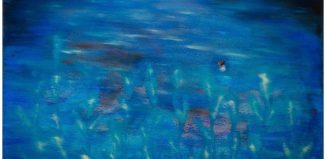A conversation between dreams and reality by Dao Xuan Tung and Bui Quoc Khanh
Written by Cao Tùng Lê for Hanoi Grapevine and VCCA, photos by VCCA.
Kindly credit Hanoi Grapevine when sharing the article.
Please do not copy or re-post without permission.
Waking up in the middle of a crowded, dark gray space. Step out, walk around, take a tour of the city… wondering if you’re walking in reality or a dream? That seems to be the feelings of whoever comes to the exhibitions “In the City” by Doan Xuan Tung and “Long Lasting Dreams” by Bui Quoc Khanh at Vincom Center for Contemporary Art (VCCA).

Doan Xuan Tung had a long journey from the countryside to the city. As an immigrant worker, he experienced many changes from the Subsidy to the Renovation periods. The journey across space-time was imprinted on his works. In “Trưa vắng” (Quiet noon) perhaps exudes a distinctive spirit throughout the 13 paintings on display: newspaper pieces plastered on shadowed figures. These human figures, at a certain point in space/time, have a certain interest in the events closely linked to that space/time point. A word-of-mouth story from a tea stall about social injustices can inadvertently create trauma and crisis of faith in a recipient’s mind. A piece of news can have a short-lived life, but one’s might not easily recover from its damage to their soul. And that damage doesn’t disappear through space, time, only fades away, like the layers of newspapers overlapping one another, until it is covered with a thick plastering of an improved life.
Doan Xuan Tung attempted to use a material that had been utilized before by many to put things into perspectives – newspapers. In many aspects – the process, the subject, the visual language – his paintings are not ‘rare’. The beauty in Doan Xuan Tung’s works is that he manages to bring an artist’s ego into a beautiful, distinctive aesthetic. The newspapers pieces break out of its assigned role as a “society-focus” material in many artistic interpretations, and now play an important factor in the composition and color scheme of the paintings. “For example, this bright part of the painting will not match with a bold font news page. There are parts that need a lot of image overlays to contrast the multi-word segments. There are parts that have images as a background then texts pasted onto it…”


Bui Quoc Khanh welcomes society in a somewhat indifferent manner, gently sketching out the surface he saw. With an overwhelming amount of details, characters, content, emotions, each detail in his paintings has a clear and specific meanings, full of elements of popular cultures from ancient to modern, from the East to the West, in bold and strong colors, interwoven with regal motifs… Bui Quoc Khanh’s paintings take life lightly, in a somewhat coarse manner, about the entwined generations of people. Khánh, with “Trò chơi lòng vòng” (Roundabout game), “Võ đài học đường” (School arena), gathered all his strength, hysterically, timidly, cautiously walked through human emotions, wildly sketching down in flesh and bones what he saw with the naked eyes and a beautiful soul. Each of Khanh’s eye movement seemingly sweeps through a social layer, bring with it the slimly, sticky colors. Layers after layers of wrongly perceived personal morals and social consciousness wildly come alive in these vibrant paintings.
Such wildness, yet in “Quy đổi” (Exchange) – a painting inspired by the idea of paying money for the time of a housemaid, and “Những giấc mơ kéo dài” (Long lasting dreams) – we see thoughts and contemplations. And with “Tự do” (Freedom), Khanh painted bare people with their necks chained, mocking the imprisonment of those tied, dangling in midair. That is why, seeing Bui Quoc Khanh’s paintings, we see the rationality of the dreamer who struggled against the harsh life.


It is a must to mention the person who discovered these two talented artists – curator Mizuki Endo (VCCA Art Director) and put these works together. If it was just one solo exhibition, it might not be so sure that these two talents could attract that many art enthusiasts. The contrast between the two artists in their observation, their creative style with the same topic creates a balance that makes each person’s voice stronger and more distinctive. Art lovers can go back and forth between two exhibition spaces, take turns with each painting, and find the conversation between their own dreams and reality.
Translated by Hanoi Grapevine













